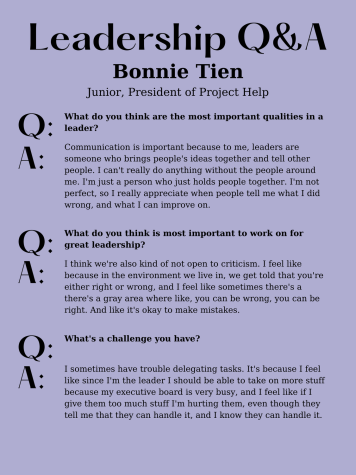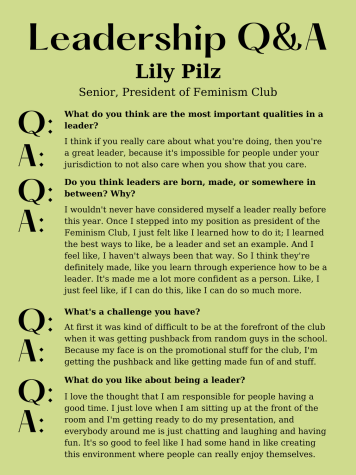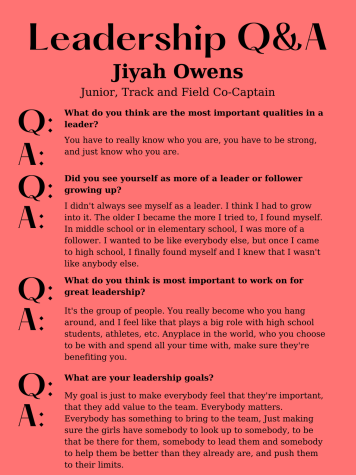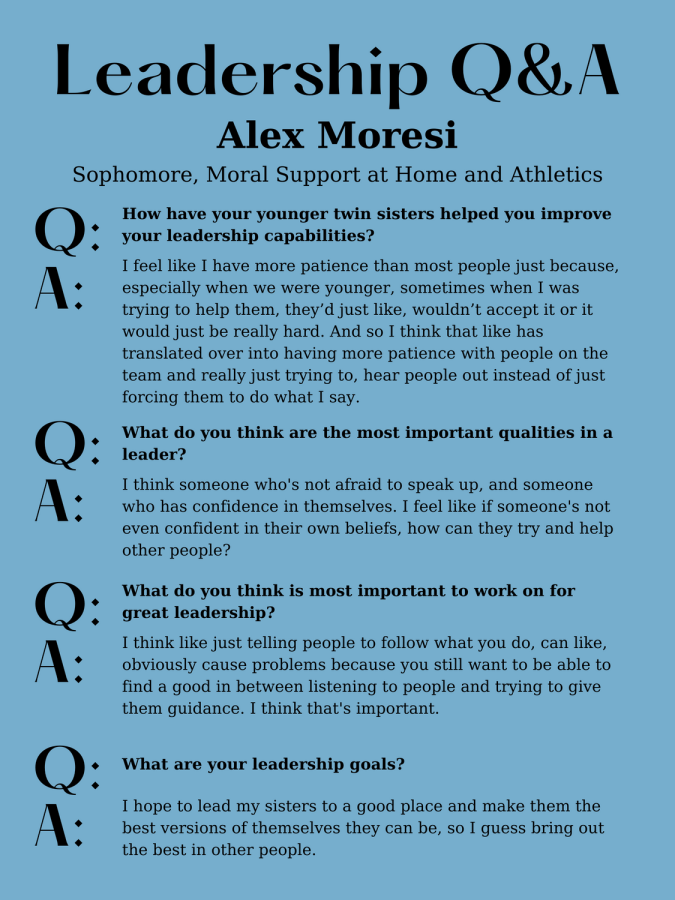What Does it Mean to be a Leader?
Discussing the intricacies of leadership at the high school level
April 12, 2023
Parkway Central is a medium-sized school, which means that offering a million and one clubs means that we’re typically hard pressed to have the member numbers that large schools have. As the school year winds down, elections are coming up, which means it is up to students, teachers, club sponsors and coaches to make decisions on student leaders for the upcoming school year.
Leadership is not just as an executive board or captain, but can be as a leader among friends or within family for younger siblings. Regardless of the context, commonly accepted traits of great leadership include empathy, reliability, listening, a willingness to keep learning, acknowledging weakness, building strengths and creating a vision.
While most of these points are obvious, some require a bit more explanation.
Leaders build something new. Whether that’s starting a club, coming up with a creative solution for a group project, or introducing a new idea into an established club, leaders who stand out take something good and make it better, or take what is available and create something never seen before. This is where continuing to learn and having a vision make a great leader.
Leaders know their people. One of the first steps to becoming a better leader is to know who you’re leading, and what they want out of the opportunity you present. Sometimes the best ideas come when looking in as an outsider, so avoid closing yourself into just one activity. If you’re a leader in one club or sport and a member in another, most lessons in leadership have plenty of crossover. People skills such as empathy, listening and communication are more specific points to work on.
Leaders have impact. They are the people you remember for a good reason. There’s a certain amount of charisma that gives people the space to trust their leaders. These people move forward, and there are people willing to follow not out of fear, but because they are moved by the same passion. Often, this comes from focusing on one’s strengths. While continuing to improve and work on one’s weaknesses is crucial, there comes a certain point where some people hit a wall in that weakness. However, if someone has a natural disposition to something, a match can start a bonfire.
Evaluating your strengths sounds rather abstract, especially in the context of a career path farther down the line. However, a more manageable way to look at this is a self evaluation without actually looking at yourself. Finding something you care about helps build an identity outside of yourself – surrounding yourself with the right people helps determine that direction, wherever it is. That, in turn, makes a vision.
A common misconception about leadership is confusing it with management. After doing some research, my best definition of the difference is that a manager guides others in their work, while a leader does that on top of creating the direction and providing that movement forward. Even though most leaders are managers on some level, managers aren’t always leaders. Both are important depending on what a position requires, but leadership is only getting more difficult as technology and the pace of the world speeds up exponentially. It’s not just businesses that need to know how to lead, but anyone who interacts with people.
One way to get better at understanding all of this is learning about types of leadership. Besides going to school and learning from different teachers what works and doesn’t work, but so does working, interning, volunteering and all of that good stuff that allows observation of the greater world. But there’s 8 billion people in the world, so some people gave names to leadership styles. A few are autocratic, democratic, situational and transformational.
Autocratic leadership works best for urgent situations where quick decision making is the highest priority, since one person typically has all of the control in this type of leadership. When I do leadership quizzes online, this is what I get. If you’ve ever been around me, I’m rather straightforward because that is how I think, and how I adapted due to the uncertainty from COVID-19. Autocratic leadership has a stigma and I’m fully aware that my obsession with power can overwhelm others, and that is certainly something to work on.
Democratic leadership is typically what people strive for in this area of the world (high school). This involves listening to the people being led and involving them in the decision making process, and works for coming up with creative solutions when people are not on a hard deadline. Groups such as STUCO and Project Help have elected executive boards and have more time in between events to plan.
Situational leadership modifies the approach to leadership depending on the people and environment and their needs. If the lacrosse and baseball teams decided to go to battle (both have sticks), a usually democratic style would have to switch to autocratic for the most time efficient battle strategy. More realistically, if a team was hit by the flu and half of the team couldn’t play, a coach would have to make a quick decision on whether to drop or play new members.
Transformational leadership is motivation oriented in order to build a team-first environment. This is usually the pep talk before a game or performance sort of leader who uses their personality in order to inspire others to become better.
While there is no right or wrong, there is effective and ineffective. Situational leadership is probably the safest to go across all boards, because it is essentially a legal cheat since adaptability to new circumstances and challenges is definitely a crucial skill to have as a leader. On the other hand, in high school, maybe there is something to be said about transformational leadership. As people who are still growing, and hopefully will continue to grow long after these foundational years, school as a safe space of transformation makes a neat coming of age story. Ultimately, growing under the right leader is about holding yourself to high standards to always strive to be the best.
To figure out what to work on, there are some studies in order to target some baseline human brain functions. Since Women’s History Month was in March and the impacts of women are on my mind, we’re still looking to learn about the differences across all genders and how those affect us in daily life. So, time for some biology and social rules from the American Psychological Association. These biological processes of course are not hard and fast rules, but generalities.
While women tend to lean democratic and transformational by encouraging cooperation in order to find their own direction, men tend to focus more on tasks and direction on the autocratic end of the scale. Men also tend to brand themselves easily, and women are more likely to downplay their accomplishments. An explanation for this is that women have a higher concentration of oxytocin, the “cuddle hormone,” which allows them to lean more into the care ethics. So, the first step to the goal is always to make people feel valued and connected. In contrast, men tend to worry about triggering cortisol, a stress hormone, which tends to happen when people are vulnerable, especially emotionally.
Taking this in, people who identify as women might want to try to be more assertive and establish a clear direction, while people who identify as men might want to consider the benefits of building mutual trust by being emotionally vulnerable at times.
Additionally, remember that teaching is a female dominated profession, though that changes from elementary to middle and eventually high school, which has more male teachers in comparison to elementary and middle schools. While thinking about leadership from what we’re exposed to, the examples we have from our teachers are typically community driven. While this works well enough since it’s what we’re used to, there are other ways to be a leader than what we’ve experienced thus far.
Final Thoughts
I think that being a “great” leader doesn’t necessarily equal being a great person. Think of some of the most impactful historical figures – you probably want to spit on their graves, but you can’t deny how effective they were.
Not everyone has to be a leader. It’s not for everyone, and sometimes even the people who appear to be fairly solid now are still growing. For a lot of people, that means that it’s taking leadership one day at a time.
I’ve been in different leadership positions in different parts of this school, so I think I’m vaguely qualified to write about this. However, through observation and going through most of high school by now, leadership is just as much of a learning opportunity as anything else. It’s the greatest challenge to those challenged in the emotional intelligence department, me included. There will always be pushback at new ideas, there will always be people who are difficult to work with, there will always be struggle. As long as you know what’s true about yourself, public opinion will hurt only as much as it needs to.






